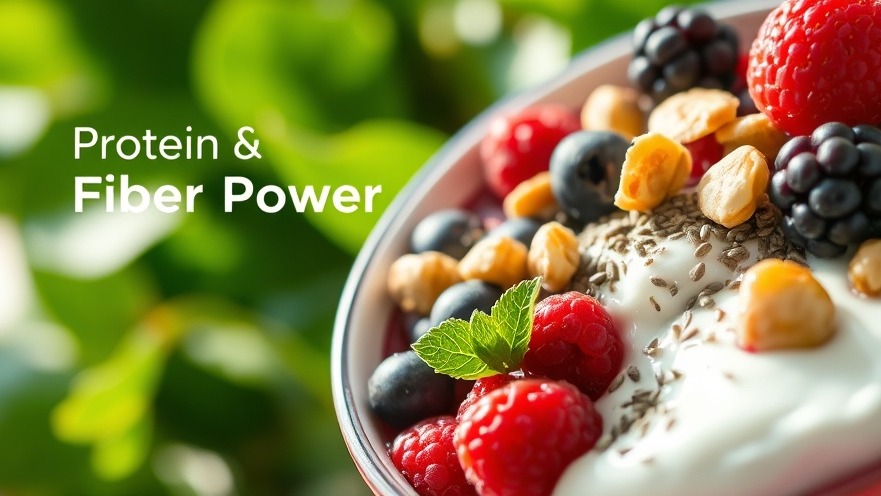
Underrated High-Protein Fiber Foods: The Nutritional Powerhouses You Should Be Eating
In a world obsessed with protein powders and supplements, many whole foods that naturally combine both protein and fiber are often overlooked. These nutritional dynamos offer the perfect combination for sustainable energy, weight management, and overall health. As a nutritional expert and dietitian, I'm excited to highlight these underappreciated foods that deserve a place in your regular meal rotation.
Why the Protein-Fiber Combination Matters
Before diving into specific foods, it's worth understanding why this combination is so valuable:
Sustained Energy: Protein takes longer to digest than carbohydrates, while fiber slows digestion even further. Together, they provide steady energy without spikes and crashes.
Enhanced Satiety: This powerful duo keeps you feeling full longer, naturally supporting weight management goals.
Digestive Health: Fiber feeds beneficial gut bacteria, supporting your microbiome while protein helps repair and maintain the gut lining.
Blood Sugar Regulation: The combination helps prevent rapid blood sugar fluctuations, beneficial for metabolic health.
Top Underrated High-Protein Fiber Foods
1. Tempeh
While tofu gets most of the spotlight, tempeh delivers more nutritional bang for your buck. This fermented soybean product contains about 19 grams of protein and 10 grams of fiber per cup. The fermentation process makes nutrients more bioavailable and creates a nutty, earthy flavor that many prefer over tofu's blandness.
How to use it: Marinate and grill tempeh slices for sandwiches, crumble into stir-fries, or use as a meat substitute in tacos.
2. Lupini Beans
These ancient legumes from the Mediterranean region pack an impressive 26 grams of protein and 4.6 grams of fiber per cup. With one of the highest protein-to-carbohydrate ratios among plant foods, lupini beans deserve far more recognition.
How to use them: Add to salads, make lupini bean hummus, or enjoy them marinated as a snack.
3. Split Peas
Often relegated to split pea soup, these humble legumes contain 16 grams of protein and 16 grams of fiber per cooked cup. Their versatility extends far beyond traditional soup.
How to use them: Make split pea dal, add to grain bowls, or puree into spreads and dips.
4. Black Soybeans
With 22 grams of protein and 15 grams of fiber per cup, black soybeans outperform both black beans and regular soybeans nutritionally. They also contain less starch than traditional black beans.
How to use them: Substitute for black beans in any recipe for a protein boost, from burritos to bean salads.
5. Pumpkin Seeds
These often-discarded seeds contain 12 grams of protein and 5 grams of fiber per cup, plus significant amounts of magnesium, zinc, and healthy fats.
How to use them: Roast with spices for snacking, add to granola, or sprinkle over salads and soups.
6. Sprouted Grain Bread
Unlike conventional bread, sprouted grain varieties contain complete proteins (containing all essential amino acids) and more available fiber. A typical slice contains 5-6 grams of protein and 3-4 grams of fiber.
How to use it: Make open-faced sandwiches topped with avocado and eggs, or use for heartier toast options.
7. Green Peas
Often mistaken as a simple vegetable side dish, green peas pack 8 grams of protein and 8 grams of fiber per cup. They're also rich in vitamins A, C, and various B vitamins.
How to use them: Blend into pestos, add to grain dishes, or mash with herbs as a side dish.
8. Amaranth
This ancient grain contains 9 grams of protein and 5 grams of fiber per cooked cup, making it more protein-rich than most other grains. It's also gluten-free and contains lysine, an amino acid often missing in other grains.
How to use it: Cook as a breakfast porridge, pop like popcorn for a crunchy topping, or use in grain bowls.
9. Wild Rice
Not actually rice but an aquatic grass seed, wild rice contains 7 grams of protein and 3 grams of fiber per cooked cup, plus impressive amounts of B vitamins and minerals.
How to use it: Mix with other grains for pilafs, add to soups, or use as a base for grain bowls.
10. Hemp Hearts
These nutritional gems deliver 10 grams of protein and 3 grams of fiber per 3 tablespoons, along with omega-3 fatty acids and numerous minerals.
How to use them: Sprinkle on yogurt or oatmeal, blend into smoothies, or incorporate into homemade energy bars.
Incorporating These Foods Into Your Diet
Practical Tips:
Start gradually: Introduce one new high-fiber food at a time to allow your digestive system to adjust.
Stay hydrated: Fiber works best when accompanied by adequate water intake.
Batch prep: Cook larger portions of legumes and grains to use throughout the week.
Create blends: Mix familiar foods with new ones—for example, combine wild rice with white rice as a transition.
Focus on flavor: Use herbs, spices, and healthy fats to make these nutritional powerhouses delicious.
Sample Meal Ideas:
Breakfast: Amaranth porridge topped with hemp hearts, berries, and a dollop of Greek yogurt
Lunch: Sprouted grain wrap with hummus, vegetables, and tempeh slices
Dinner: Wild rice pilaf with roasted vegetables, black soybeans, and pumpkin seeds
Snack: Roasted lupini beans with herbs and spices
Conclusion
By incorporating these underrated protein-fiber combinations into your diet, you'll not only diversify your nutrient intake but also support long-term health goals. These foods prove that sometimes the most nutritionally dense options aren't the ones getting all the attention in health magazines or social media. Simple, whole foods can deliver exceptional nutritional benefits when we know where to look.
Remember that sustainable dietary changes happen gradually. Start by introducing one or two of these foods into your regular rotation, and build from there. Your body—and especially your digestive system—will thank you for the balanced approach to protein and fiber intake.
 Add Row
Add Row  Add
Add 




Write A Comment